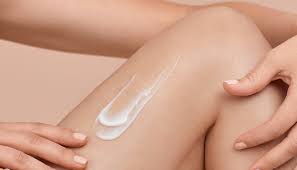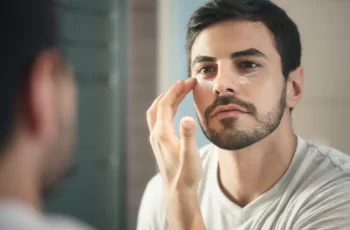Can I use Hyaluronic Acid on my Arms and Legs?
Since the day hyaluronic acid made its way into our daily skincare routine, we have been obsessed ever since! Naturally occurring in the body as well as being derived from sugar cane, this clever ingredient has various benefits and abilities to hydrate the protective skin barrier ensuring the skin is fully protected from environmental aggressors. Not to mention how it target signs of dehydration reducing the appearance of fine lines and wrinkles. And those are only a couple of the benefits you can expect to see when using hyaluronic acid in your everyday skincare routine, you understand our obsession a little better now right?
The magic of hyaluronic acid doesn’t stop at skincare benefits, it is also praise for the impressive hydrating results you can expect to see when using it on the body too, so this leads me to finding out can you use hyaluronic acid on your arms and legs? Let’s dive right in and find out more.
Can you put hyaluronic acid on your body?
You can indeed, in fact, many skincare experts rave about the effects of using body gels, lotions, and creams enriched in hyaluronic acid can revive tried looking skin on the body, especially on areas that can become quite dry, such as arms, elbows, legs and knees. You’ll really notice a difference and improvement in the overall skin health if you find you have experienced sunburn or excessive sun exposure. This will often lead to the skin on the body and face feeling tight, dry, and uncomfortable. Be sure to take with you a body gel packed with hyaluronic acid on any tropical and warm holidays to keep your skin healthy, hydrated, and in its happiest state.
What skin type should use hyaluronic acid?
Hyaluronic acid is suitable for almost all skin types, this is because all skin types are likely to suffer from dehydration. Thanks to the humectant traits of HA, you’ll find it is able to draw in moisture surrounding the face and even the water content of skincare formulas can be locked into place. This leaves you with a plumped, hydrated, and youthful complexion. The main skin types that will gain optimal results are those who are dry and prone to flare-ups in certain conditions such as eczema, psoriasis, and even dryness from day-to-day exposure to central heating and harsh climates to name a few environmental aggressors. As for oily skin types, you’ll find that they also suffer from dehydration which not only leaves the skin barrier weakened to potential damage, but you’ll also find that signs of ageing, such as fine lines and wrinkles, become more noticeable.
Can you put hyaluronic acid on your hands?
Absolutely! Using a daily hand cream packed with hyaluronic acid, and SPF will ensure the skin on the hands are fully protected from damage with fine lines and areas of dryness combated, as well as a helpful boost in collagen giving them a replenished and youthful appearance.
Quite often our hands are the last thing we think of when it comes to self-care. But due to the fact they are continuously exposed to daily free radicals, such as UV rays and bad weather they are one of the first areas of your body that show signs of ageing, from fine lines and dark spots of pigmentation also called age spots.
What happens if you use too much hyaluronic acid?
Sadly, you can have too much of a good thing. You can indeed use too much hyaluronic acid and because of its hard-working humectant tendencies, you’ll be left with skin that feels thirstier. The reason for this is because hyaluronic acid never stops working at drawing in moisture from air around the face and other skincare products formulas. If HA (hyaluronic acid) finds there isn’t enough humidity in the air or product formulas, it will simply begin drawing moisture up from the lower layers of the skin which unintentionally prevents the skin from gaining the optimal results.
Is it OK to use hyaluronic acid every day?
Yep, you certainly can! In fact, it is strongly advised to use hyaluronic acid enriched products twice a day. To get the most out of it use it during your morning and evening routine by applying it onto freshly cleansed skin, preferably that is still slightly damp to kick start hyaluronic acid’s humectant traits. You’ll find that using serums enriched in hyaluronic acid will keep the skin barrier plumped and hydrated which will lead to any other products you apply to the face will be absorbed rapidly and leaving you with fast results.
Much like all skincare ingredients it is important that you ensure they are the best for you and your skin. Therefore, I suggest consulting with a doctor or dermatologist, as well as perform a patch test on the skin for 24 hours to avoid any unwanted reactions.
Does hyaluronic acid have side effects?
The short answer is, not really, this is because hyaluronic acid is generally considered very safe for almost all skin types to use. There have been very few reports about any side effects experienced from introducing hyaluronic acid into your daily skincare routine. Having said that, as I have already mentioned it is important to ensure you and your skin will benefit from this powerhouse ingredient in your routine.
Should I apply hyaluronic acid on wet skin?
Yes, because hyaluronic acid is a magnet for water it will thrive when it is applied to wet skin. Bearing in mind of course, that you wouldn’t want your skin to be too wet as this will prevent the skincare formula to absorb into the skin surface. As a rule, for skincare application, it is considered best to work your way from the thinnest formulas to thickest formulas. This is ideal for you to reap the rewards of serums enriched with hyaluronic acid that is applied after cleansing and exfoliating toners, but before thicker moisturisers.
So, there you have it, hopefully I have answered some if your questions about using hyaluronic acid on your arms and legs. Don’t forget if you have any more questions come and follow us in Instagram, you can find me in the DMs.
DQH Knowledge drop: In your 20s, your skin cell turnover decreases. (Cell turnover is a key component in keeping your skin youthful.) You know what else slows down? Your collagen production. Starting in your 20s, collagen decreases by about 1 percent per year. Should you want to prevent fine lines and wrinkles, start by eliminating behaviors that contribute to premature aging. “If it’s bad for you, it’s bad for your skin,” says dermatologist Michel Somenek.
“Cigarette smoking reduces blood flow to the skin and causes premature wrinkling and a dull skin texture. Making the repeated pursed motion to inhale can also cause smoker’s lines. Alcohol and recreational drugs are toxins for the skin that damage its cellular structure and DNA,” Somenek tells us. “The faster you eliminate vices while you are young, the better chance your skin and body have to recuperate.” Also, adopting an anti-aging routine in your 20s is key. After all, the best offense is a good defense. We spoke to Somenek and experts Joshua Ross and Audrey Kunin to find out more.
Keep reading for the best anti-aging products for your 20s, according to skincare professionals.
Sunscreen
“We all know that the sun is the number one cause of skin aging and starting the prevention in your 20s is very important,” Ross says. “The majority of your sun damage won’t start to appear until you’re in your 30s, so don’t wait until you see it surface or you’ll be behind the curve. Stay ahead of it with a good-quality zinc-based sunscreen worn daily.”
Farmacy Green Defense Daily Mineral Sunscreen
An invisible sunscreen with SPF 30, plus botanical extracts meant to protect skin with tons of antioxidants. Bonus: It’s clean and fine to use under makeup.
Bareminerals Complexion Rescue™ Tinted Moisturizer Broad Spectrum SPF 30
Although we recommend you use your SPF and moisturizer separately, we also understand moments when you don’t have time or energy for that extra step. For those times, this bareMinerals moisturizer is a great thing to have on hand.
Vitamin C Serum
“A great introduction to anti-aging is to start with a vitamin C serum in your morning skincare routine,” Ross says. “It’s a powerful antioxidant that will neutralize free radicals and brighten the skin.” He adds that it’s a great way to counteract the effects of the sun’s harmful rays, which, as previously mentioned, are among the biggest causes of premature aging.
Drunk Elephant C-Firma™ Vitamin C Day Serum
The Drunk Elephant C-Firma is a lightweight serum that promises to give skin a glow by combining the brightening powers of vitamin C with ferulic acid, l-ascorbic acid, and vitamin E. The included sodium hyaluronate is meant to replace hydration loss, so you shouldn’t have to deal with any irritation.
Sunday Riley C.E.O. Rapid Flash Brightening Serum
This potent serum is jam-packed with vitamin C (15 percent, to be exact), which means it’s a potential superstar at both brightening skin and dousing it in antioxidants.
Peptides
Using peptides on your skin has many benefits, says Somenek. “The skin barrier is what defends the body against pollution, UV rays, bacteria, and toxins. It can be damaged by several everyday factors. Using topical peptides aids in building a stronger barrier,” he says. “Peptides comprise elastic fibers, which are a type of protein. These fibers help to make skin appear taut and firm. Peptides can also help repair damaged skin, relieve inflammation, and even out skin tone. Some peptides can kill acne-causing bacteria that is common in 20-somethings.”
Kunin agrees, saying, “Peptides are an excellent entry point for supporting collagen.” She recommends looking for face and eye treatments that contain these collagen-boosting powerhouses.
Charlotte Tilbury Magic Eye Rescue Cream
This Charlotte Tilbury super-emollient eye cream has a base of coconut oil and shea butter (read: it’s incredibly hydrating). Botanicals plus peptides are meant to help reduce dark circles and boost collagen, respectively.
This creamy moisturizer serves up potent collagen-boosting peptides and pycnogenol, and antioxidant-rich vitamin C. “Instead of sitting on top of the skin, peptides penetrate the outer layer so they go deep. The ‘signals’ they send tell the cells to produce elastin and collagen, which are needed for youthful-looking skin,” explains Somenek.
At-Home Peel Pads
Remember that skin cell turnover fiasco we talked about earlier? One way to help support it is by exfoliating. “Exfoliation is important to help keep skin fresh and luminous,” Kunin says. She recommends using at-home peel pads as an easy and effective way to exfoliate.
“The goal in your 20s is to fight the slowing pace of cell turnover. It is wise to use products that gently exfoliate, yet still remove oil and other impurities. Products that have Alpha Hydroxy Acids (AHA) or Beta Hydroxy Acids (BHA) are a good choice.”
According to Somenek, you should only exfoliate two to three times a week. “People of all ages are guilty of over-exfoliating and that can be too much of a good thing,” he says.
Dermadoctor Kakadu C Intensive Vitamin C Peel Pad
A few swipes of this Derma Doctor powerful peel pad promise to leave your skin glowing and smooth, thanks to the seven (yes, seven) types of chemical exfoliants, including AHA and BHA. It also contains vitamin C via Kakadu plum extract for added brightening and antioxidant protection.
KEY INGREDIENTS Kakadu plum extract is sourced from the Kakadu plum, a fruit grown in northern Australia. It contains vitamin C, which restores the skin’s natural barrier, increases collagen production, and soothes irritation.
Dr. Dennis Gross Skincare Alpha Beta® Universal Daily Peel Pads
These are the gold standard of peel pads, with a cult following and over 900 five-star reviews on Sephora. They’re easy to use and contain a blend of anti-aging exfoliating acids.
Emollient Night Cream
“In your 20s, you need to start upping the hydration in your skincare routine. You may have been cautious of over-moisturizing because of acne in your teens, but as you enter your 20s, your skin transitions and becomes drier,” Ross says. “I recommend an emollient night cream added into your evening skincare regimen.”
“Twenty-somethings need to make sure that they are not using creams that will clog their pores and cause excess oil production,” says Somenek. Opt for non-comedogenic products.
Cerave Skin Renewing Night Cream
One great choice is the CeraVe Skin Renewing Night Cream, which is a non-comedogenic night cream that leaves skin soft and glowy. It combines the moisturizing powers of ceramides and hyaluronic acid.
RoC Retinol Correxion Max Hydration Creme
“The best night cream ingredients contain retinol, benzoyl peroxide, and/or salicylic acid or hyaluronic acid. The goal is to moisturize, yet remove excess oil,” says Somenek. This Roc Retinol Correxion cream fits the bill as it contains both hyaluronic acid and retinol so it promises to moisturize while also being non-comedogenic.



